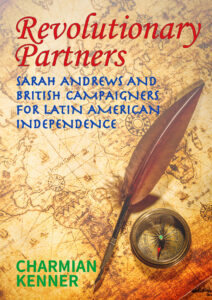Naomi Clifford's Blog
March 13, 2025
The Legend of Margaret Catchpole – for Suffolk Roots

Suffolk Roots, the Quarterly Journal of Suffolk Family History Society, published my article on Margaret Catchpole (Vol. 50, No. 4, March 2025).
READ THE ARTICLEThe post The Legend of Margaret Catchpole – for Suffolk Roots appeared first on Naomi Clifford.
April 28, 2023
Kitty Cochrane: Adventurer for Latin American Independence
It is my great pleasure to host an extract of Charmian Kenner’s new book Revolutionary Partners: Sarah Andrews and British Campaigners for Latin American Independence.
Charmian Kenner sets the scene:
Naomi’s blog about Thomas Cochrane and Kitty Barnes told the story of a daring Scottish naval captain and his young bride, who eloped in 1812. My book Revolutionary Partners: Sarah Andrews and British Campaigners for Latin American Independence complements this tale by documenting Kitty’s exploits in Chile and Peru in 1817, when these countries were fighting for freedom from Spain.
 Katherine Barnes Cochrane, the Countess of Dundonald, by George Henry Harlow.
Katherine Barnes Cochrane, the Countess of Dundonald, by George Henry Harlow.At this point Thomas Cochrane had been made commander of the Chilean patriot navy, tasked with expelling the Spanish royalist fleet from the Pacific coast. He was to be successful, thus securing the independence of Chile and Peru. Kitty Cochrane contributed to the cause through notable deeds of her own, as shown in this extract from Revolutionary Partners.”
Kitty’s first challenge took place when her husband was away on an expedition to Peru, whilst she remained in Chile. An intruder working for the Spanish broke into Kitty’s house and threatened her with death unless she revealed secret orders given to Cochrane, but she refused. In her struggle to retain a vital document, Kitty received a wound from the assailant’s stiletto knife before he was apprehended. However, she responded with mercy to his wife’s appeal to save the condemned man’s life.
Kitty was later entrusted with vital dispatches for Mendoza in Argentina, on the other side of the Andes from the Chilean capital of Santiago. To reach Mendoza, she had to brave the 12,500ft Uspallata Pass close to the majestic peak of Aconcagua, the highest in the Americas at 22,800ft. The pass being blocked by snow, Kitty took refuge in a casucha, a stone shelter where she slept on a dried bullock’s hide.
During this trek, Kitty’s life was endangered again by a royalist infiltrator, who rode towards her on a precipitous path where the slightest false step would have sent her tumbling into an abyss. Fortunately her devoted bodyguard Pedro Flores caught up with the would-be attacker and struck him, causing him to flee and enabling Kitty to accomplish her mission.
Kitty herself was evidently an expert horserider, as William Miller, another British officer fighting with the patriots, described on the occasion when she galloped into the plaza at the Peruvian port of Huacho during a review of his cavalry troops. According to Miller, ‘the sudden appearance of youth and beauty on a fiery horse, managed with skill and elegance, absolutely electrified the men’, who exclaimed that she was ‘un angel del cielo’ (an angel from the sky). Miller told them ‘this is our generala‘, and Kitty bowed to the troops, who burst out with loud cries of ‘viva!’
Lady Cochrane’s duties as generala included defending her husband’s reputation in England whilst he conducted his campaign. She returned there for a time, partly for health reasons (she would soon give birth to another child), but also because Cochrane was at risk from the Foreign Enlistment Bill, under which he could have been prosecuted for taking up service against the Spanish in the cause of independence.
 Thomas Cochrane, Earl of Dundonald, engraved by John Cook, aft. James Ramsay. Public domain, via Wikimedia Commons.
Thomas Cochrane, Earl of Dundonald, engraved by John Cook, aft. James Ramsay. Public domain, via Wikimedia Commons.Kitty came back with her infant daughter, whose health was not robust, and she decided to move from the Peruvian coast to the interior for a change of climate. They travelled on horseback across a desert under the intense heat of the sun, to Quilca where they were feted at the palace of a Marquesa. However, the baby became seriously ill soon after their arrival.
With no medical help available, Kitty chose to return to the coast, but the royalist army was advancing nearby and she discovered they were planning to take her hostage with her child that very evening. With characteristic decisiveness, she left instantly.
Kitty’s party travelled all night and the following day without stopping, but came to a fast-flowing river that could only be crossed by a perilous rope bridge. Such ‘torrent bridges’ consisted of six ropes made from cane or hide, four forming the floor with sticks laid across them, and two the parapet on either side. Travellers could only cross one at a time, and the ropes curved downwards under their weight, suspending them as if in a bag swaying above the water.
The sound of a royalist bugle was heard close behind and there was no time to lose. Kitty picked up her baby daughter and set out across the bridge. As she reached the centre, the ropes swayed so much that she had to lie down with the child held tightly in her arms, hanging above the raging torrent.
Once again the faithful officer Pedro Flores came to her aid, crawling towards her and taking the baby across. He planned to return for Kitty, but she completed the crossing alone. With the whole party safely over the river, the rope bridge was cut, making it impossible for the Spanish army to follow them.
Kitty thus reached the Peruvian coast and joined her husband on the warship O’Higgins at the port of Callao. However, she had escaped from one danger to face another, since Cochrane immediately decided to pursue a Spanish ship of war laden with treasure. Kitty insisted on remaining on deck during the attack. She was standing close to one of the guns, and when the gunner hesitated to fire due to her proximity, she was concerned he could be punished for disobeying orders. Seizing his arm, she directed the match to light the fuse, although the resulting explosion caused her to faint as the gun went off.
Soon afterwards, however, Kitty came back on deck and the whole crew burst out with a rendition of the Chilean national anthem, adapted to include a prayer for a divine blessing on Kitty and her husband. As Cochrane recorded, this unexpected tribute was ‘so overwhelming as to affect her Ladyship more than had the din of cannon’.

Revolutionary Partners: Sarah Andrews and British Campaigners for Latin American Independence is available as a free download.
In addition to Kitty’s story, it reveals the experiences of other women who supported the struggle, including Sarah Andrews, partner of Venezuelan revolutionary Francisco de Miranda, and Mary English and Maria Graham who travelled to Latin America and witnessed the dawn of a new society.
DOWNLOAD THE FREE BOOKThe post Kitty Cochrane: Adventurer for Latin American Independence appeared first on Naomi Clifford.
September 7, 2022
Just published – Out of the Shadows: Essays on 18th and 19th Century Women
The post Just published – Out of the Shadows: Essays on 18th and 19th Century Women appeared first on Naomi Clifford.
January 6, 2022
A new book about Vauxhall Gardens!
The post A new book about Vauxhall Gardens! appeared first on Naomi Clifford.
August 18, 2021
My next talk: Self-Publishing Your History Book
The post My next talk: Self-Publishing Your History Book appeared first on Naomi Clifford.
April 27, 2021
Property Rites: How ‘modern’ is the story of Mary Ashford?
The post Property Rites: How ‘modern’ is the story of Mary Ashford? appeared first on Naomi Clifford.
February 6, 2021
Talk – “By her own consent”: The Murder of Mary Ashford and Rape Culture in the Georgian Era

This is a live online event. Bookers will be sent a link in advance giving access.
Please come to my online presentation on the murder of Mary Ashford in 1817 on 9 March 2021 at 7pm. I will be exploring the rape culture of the 18th and early 19th century through the notorious case of Mary Ashford whose death in Erdington, near Birmingham because a cause célèbre.
Local gentlemen were so outraged that the man accused of her rape and murder was acquitted that they funded a second trial. So why did they also blame Mary for her own death? 200 years on, has anything really changed for women in the #metoo era?
DetailsWhere: Online
Who: Naomi Clifford
When: Tuesday 9 March 2021, 7pm
Price: FREE
A Friends of Carnegie Library event.
To book send an email to CarnegieLibrary@Lambeth.gov.uk.
The post Talk – “By her own consent”: The Murder of Mary Ashford and Rape Culture in the Georgian Era appeared first on Naomi Clifford.
November 3, 2020
Talk: ‘By her own consent’ – The Murder of Mary Ashford and Rape Culture in the Georgian Era

This is a live online event. Bookers will be sent a link in advance giving access.
Please come to my online presentation on the murder of Mary Ashford in 1817 on 8 December 2020 at 7pm. I will be exploring the rape culture of the 18th and early 19th century through the notorious case of Mary Ashford whose death in Erdington, near Birmingham because a cause célèbre.
Local gentlemen were so outraged that the man accused of her rape and murder was acquitted that they funded a second trial. So why did they also blame Mary for her own death? 200 years on, has anything really changed for women in the #metoo era?
Details
Where: Online
Who: Naomi Clifford
When: Tuesday 8 December 2020, 7pm
Price: FREE
A Vauxhall History/Friends of Tate South Lambeth Library event
I will be sending out details of how to sign up shortly. In the meantime, mark it in your diary and watch this space.
The post Talk: ‘By her own consent’ – The Murder of Mary Ashford and Rape Culture in the Georgian Era appeared first on Naomi Clifford.
July 4, 2020
5 Georgian era drinking scenes
The post 5 Georgian era drinking scenes appeared first on Naomi Clifford.
May 10, 2020
“Is she or isn’t she?” How an age-old plea of pregnancy saved women from execution
The post “Is she or isn’t she?” How an age-old plea of pregnancy saved women from execution appeared first on Naomi Clifford.



